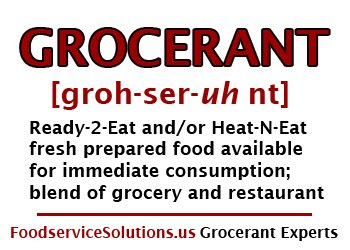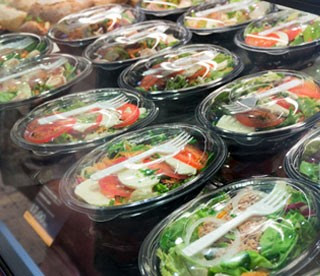A household is defined by the U.S. Census Bureau as all the people who occupy a
single housing unit, regardless of their relationship to one another.
There were 37 million one-person
households in 2021, or 28% of all U.S. households. While 35.03 percent of all households in
the United States were two person households. Combined 63.03% of all U.S.
households have just one or two people living in them.
More than ever demographics continue
to drive change in everything we do. The change in population mix including fewer
married couples, more people living alone, smaller household size
and multi-generational households each are creating new opportunities for food
retailers and packaging companies.
Foodservice
Solutions® Grocerant Guru®, Steven Johnson is constantly
asked why is the Grocerant niche filled with Ready-2-Eat and Heat-N-Eat fresh
food driving change in every aspect of the retail food space? Demographics are
changing Gen Z, and Millennials spend more often on food than
any other demographic in the U.S.
Packaged
Facts in an important report on food and beverage packaging entitled Food
and Beverage Packaging Innovation in the U.S.: Consumer Perspectives, published
by Packaged
Facts outlined
five key drives shaping packaging.
The
five drivers are:
1.
Targeting Millennials:
While millennials may seem like a broad and amorphous target, numerous studies
show there are some commonalities. Millennials like fresh, less processed
foods, as demonstrated by their preference for “fast casual restaurants that
offer freshly prepared foods, and shopping the perimeter of grocery stores
where fresh and non-packaged foods can be found.”
2.
Smaller Packages are a Big Trend in Packaging: With one- or two-person households
representing 61 percent of all U.S. households, packages sized to serve one or
two people have become a big trend in packaging. Such formats include
single-serve packaging, meals for two, multi-packs of individual portions, and
resealable packaging. The rise in smaller-footprint stores is also influencing
this trend.
3.
Packaging for Convenience: Convenience is a major selling point for food and
beverage packaging. Features such as ease of opening, re-seal-ability,
portability, lighter weight, and no-mess dispensing are packaging benefits that
influence consumers’ purchasing decisions positively.
4.
See-Thru Packaging Can Boost Sales: More and more marketers are putting
their products in packages that are see-thru or have see-thru windows.
Transparency in packaging taps into consumer desire for transparency about how
food and beverages are produced, both figuratively and literally. Companies
that are transparent about their ingredients, sourcing, and business practices
are reaping the benefits in consumer goodwill and trust.
5.
Eco-Friendly Packaging Growing: In the past few years, single-serve
bottled water has come under attack by environmentalists as epitomizing the
wasteful nature of modern society. As a result, some marketers of bottled water
have stepped up their introductions of more sustainable packaging. Likewise,
Packaged Facts believes that improved recyclability and sustainability will
become ever more important to the success of the single-cup brew market — if
not a cost of entry — as this business matures. In the past two years, several
American and Canadian marketers have introduced more environmentally friendly
designs for use in K-Cup brewers.
Success
does leave clues and have the right packaging helps drive
success. The Grocerant niche filled with Ready-2-Eat and Heat-N-Eat
fresh prepared food will continue to drive change in all areas of retail food
service. Do you know where most meals are consumed? Where are you
selling meals?
Now
over the last several months, sales for most food categories have been up due
to inflation, but unit sales have been down. That is not the case for in-store
bakery. Sales have been inflated and unit sales have either been flat or up
slightly. According to the latest International Dairy Deli Bakery Association
(IDDBA) research, 2022 showed $3.3 billion in total in-store bakery sales, with
$1.9 billion coming from the center store and $1.4 billion coming from the
perimeter.
The
needs of shoppers are also evolving in this category. Where Baby Boomers are
used to going aisle by aisle to find the products they want, Gen Xers and
Millennials shop differently, and grocers need to change the way they do things
if in-store bakery is going to continue to thrive. The younger consumer is
looking for personalized offers via social media. So, if you have a sale on
turnovers, you better take to TikTok or Instagram. The new shopper is not
going down every aisle. They are coming with an agenda (if they come in person
at all) and are approaching the shelves in a targeted fashion.
“That
whole under-40 generation is not visiting the in-store bakery as frequently as
the Baby Boomer generation did,” said Jonna Parker, principal of fresh foods
for Circana (formerly IRI). “So you need to leverage social media
and digital advertising to the right audience to make a play there.”
Parker
pointed to the overnight success of Costco’s chocolate peanut butter pie. The
dessert experienced its moment on social media; and shoppers went nuts.
“If
that is not proof perimeter bakery can create a viral adventure, I don’t know
what is,” Parker said.
The
younger crowd also is not one to overindulge, which means single servings of
desserts and other items are now starting to move more rapidly.
“[Gen
Zs and Millennials] are not big leftover eaters,” said Rick Stein, vice
president of Fresh Foods at the Food Industry Association (FMI). “So,
we are seeing that single-serving section really being expanded. We’re seeing
our members really start to gravitate to these grab-and-go items.”
Parker
said that buying enthusiasm is linked to the emergence of the perimeter of the
in-store bakery, where a lot of these single servings are put out on display.
Under-40
buyers also demand freshness, but there’s also a contradiction to that
behavior, which is that younger consumers typically have bought food at night
when the bakery staff is long gone. The habit is changing, and more buyers are
starting to come earlier in the day. Still, it is creating an issue for store
managers who are looking to offer the freshest items possible.
This
is where baked goods with longer shelf lives are thriving, particularly at the
supercenters. Families also appreciate food with a longer sell-by date.
Other
emerging bakery trends include variety (taste and size) as well as
international flavors.
“That’s
a growing part of the business we really have not seen in the last several
years,” Whitney Atkins, global marketing vice president at IDDBA, said. “I
think [bakers] were very innovative during COVID and they took that time to
learn how to really hit the consumers in some different ways.
Atkins
said Asian flavors are ranking high among shoppers. Ube, a purple yam with a
nutty vanilla flavor, is native to Southeast Asia and predominantly used in
Filipino cuisine. Another flavor is Yuzu, a Japanese citrus lemon valued for
it’s highly aromatic rind. Blends of spicey-sweet are also hot right now,
Atkins said.
Since
the COVID-19 pandemic, work from home flexibility has increased for many, and
higher prices are impacting the abilities of families to eat out. According to
first quarter numbers from IDDBA, 29% of Americans work from home at least
twice a week. That number is down compared to 2021 (47%) and 2022 (41%).
Rochester,
N.Y.-based Wegmans said it has been affected by an increase in remote work. The
company is currently testing a pilot moving towards self-serve coffee stations,
citing an increase in work-from-home as a pain point to its full-service coffee
options.
Yet
other parts of bakery are still rebounding from pandemic-related changes in
behavior.
“Some
of the issues on donuts probably stem from how it got really hurt during COVID
because you could not buy single donuts anymore,” Stein said. “I think as that
department has reopened up now and back into full selection consumers can go
back to picking.”
Atkins
said just the excitement of selecting your own donuts post COVID has helped
lead the resurgence.
The
pandemic also drove a trend of making dishes from scratch, especially with
regard to desserts. However, inflation is now contributing to a perception that
buying individual ingredients may be more expensive than grabbing something out
of the bakery.
Convenience
and time also are king when it comes to households with busy schedules. Stein
said more households are bringing premade dinners into the home, and with that
comes the sweet after meal.
Gatherings
also continue to be on the rise, and many happen at the home. Pool parties, game
nights and holiday events also are another way consumers are combating
inflation, according to Parker.
The
grocers capitalizing on those types of events are the ones leaning into
advertising that highlights bakery’s role. For pool parties, it might be an
illustration showing kids getting together and offering a food solution like
brownies.
Invite Foodservice Solutions® to complete a
Grocerant ScoreCard, or for product positioning or placement assistance, or
call our Grocerant Guru®. Since 1991 Foodservice
Solutions® of
Tacoma, WA has been the global leader in the Grocerant niche. Contact: Steve@FoodserviceSolutions.us or
253-759-7869


















